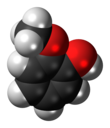Guaiacol
| |||
| Names | |||
|---|---|---|---|
| Preferred IUPAC name
2-Methoxyphenol | |||
| Other names
o-Methoxyphenol
O-Methylcatechol[2] 2-Hydroxyanisole Pyroguaiac acid Pyrocatechol monomethyl ether 1-hydroxy-2-methoxybenzene | |||
| Identifiers | |||
3D model (
JSmol ) |
|||
| ChEBI | |||
| ChEMBL | |||
| ChemSpider | |||
ECHA InfoCard
|
100.001.786 | ||
| KEGG | |||
PubChem CID
|
|||
| UNII | |||
CompTox Dashboard (EPA)
|
|||
| |||
| |||
| Properties | |||
| C7H8O2 | |||
| Molar mass | 124.139 g·mol−1 | ||
| Appearance | colorless oil or crystalline solid | ||
| Density | 1.112 g/cm3, liquid 1.129 g/cm3, crystals | ||
| Melting point | 26–29 °C (79–84 °F; 299–302 K) | ||
| Boiling point | 204–206 °C (399–403 °F; 477–479 K) | ||
| 23.3 g/L at 25 °C | |||
| Related compounds | |||
Related methoxyphenols
|
3-Methoxyphenol
| ||
Except where otherwise noted, data are given for materials in their standard state (at 25 °C [77 °F], 100 kPa).
| |||
Guaiacol (
Occurrence
Guaiacol is usually derived from guaiacum or wood creosote.
It is produced by a variety of plants.
Preparation
The compound was first isolated by Otto Unverdorben in 1826.[8] Guaiacol is produced by methylation of o-catechol, for example using potash and dimethyl sulfate:[3]
- C6H4(OH)2 + (CH3O)2SO2 → C6H4(OH)(OCH3) + HO(CH3O)SO2
Laboratory methods
Guaiacol can be prepared by diverse routes in the laboratory.
- C6H4(OCH3)2 + C2H5SNa → C6H4(OCH3)(ONa) + C2H5SCH3
Uses and chemical reactions
Syringyl/guaiacyl ratio
Chemical intermediate
Guaiacol is a useful precursor for the synthesis of other compounds.[12] Being derived from biomass, it is a potential component or precursor to "green fuels".[13]
Guaiacol is also a useful reagent for the quantification of peroxidases, as in the presence of hydrogen peroxide these enzymes will catalyse with it the formation of tetraguaiacol,[14] a coloured compound that can be quantified by its absorbance at 420–470 nm, following the equation:
- 4 guaiacol (colorless) + 2 H
2O
2 → tetraguaiacol (colored) + 8 H
2O.
Medicinal and food
Guaiacol is a precursor to various
Guaiacol is also used medicinally as an
Guaiacol is produced in the gut of
Safety
Methoxyphenols are potential biomarkers of biomass smoke exposure, such as from inhalation of woodsmoke. Dietary sources of methoxyphenols overwhelm the contribution from inhalational exposures to woodsmoke.[19]
See also
References
- ^ Merck Index (13th ed.). p. 4568.
- ^ "List of synonyms for guaiacol". Chemindustry.
- ^ ISBN 978-3527306732.
- PMID 830476.
- ISBN 978-0849394126.
- ^ Gallegos, Jenna (August 17, 2017). "The best way to drink whiskey, according to science". The Washington Post.
Guaiacol is what gives whiskey that smoky, spicy, peaty flavor.
- PMID 12952431.
- PMID 20322688.
- ^ Mirrington, R. N.; Feutrill, G. I. (1988). "Orcinol Monomethyl Ether". Organic Syntheses; Collected Volumes, vol. 6, p. 859.
- PMID 11449052.
- ISSN 0961-9534.
- .
- .
- PMID 7673205.
- ^ Allen, C. F. H.; Gates, J. W. Jr (1955). "o-Eugenol". Organic Syntheses; Collected Volumes, vol. 3, p. 418.
- ^ Esposito, Lawrence J.; Formanek, K.; Kientz, G.; Mauger, F.; Maureaux, V.; Robert, G.; Truchet, F. (1997). "Vanillin". Kirk–Othmer Encyclopedia of Chemical Technology. Vol. 24 (4th ed.). New York, NY: John Wiley & Sons. pp. 812–825.
- ^ "Guaiacol". DrugBank. 2019-11-02. Retrieved 2019-11-18.
- S2CID 5207502.
- ^ Smith, K. R. (2005). "Critical review of the health effects of woodsmoke" (PDF). School of Public Health, University of Berkeley. Archived from the original (PDF) on 2009-07-10.


